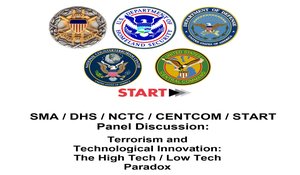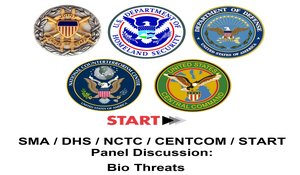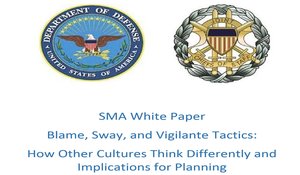
Terrorism and Technological Innovation: The High Tech / Low Tech Paradox
Terrorism and Technological Innovation: The High Tech / Low Tech Paradox Panel Discussion Speakers: Braniff, B. (University of Maryland START); Ligon, G. (University of Nebraska, Omaha); Rassler, D. (Counterterrorism Center [CTC]) Date: 28 February 2018 Speaker Session Preview SMA hosted a panel discussion as a part of its SMA DHS NCTC CENTCOM START Speaker Series, […]
Continue Reading
Principles of Response to Aggression in Space
[Q18] What are the principles (e.g., flexible vs. controlled response; proportionality, etc.) upon which international policy makers should develop response options for aggression in space? A Virtual Think Tank (ViTTa)® Report. Author(s): Dr. John Stevenson (NSI, Inc.) Summary Response Upon considering the question of focus, several expert contributors argue that it is confusing or even […]
Continue Reading
Effectiveness of International Agreements in Space
[Q22] Can international agreements effectively protect high-value space assets in time of crisis and/or conflict? How could such a treaty be sufficiently verified? How would it be enforced? How would dual- use technologies be treated? A Virtual Think Tank (ViTTa)® Report. Author(s): Dr. John Stevenson (NSI, Inc.) Summary Response The expert contributors divided nearly evenly […]
Continue Reading
Commercial Space Actors: Disruptors or Solid Partners
[Q12] Will major commercial space entities likely serve as disruptors or solid partners in terms of state national security interests? In the short-term (5-10 years), mid-term (15-20 years), and long-term (25+ years)? A Virtual Think Tank (ViTTa)® Report. Authors: Dr. Allison Astorino-Courtois (NSI, Inc.) and Dr. Belinda Bragg (NSI, Inc.) Summary Response There was considerable […]
Continue Reading
Bio Threats Panel Discussion
Bio Threats Panel Discussion Speakers: Ackerman, G. (University of Maryland START); Earnhardt, R. (University of Maryland START); Gronvall, G. (Center for Health Security at Johns Hopkins University); Casagrande, R. (Gryphon Scientific) Date: 23 February 2018 Speaker Session Preview This speaker session covered the environment in which non-state actor adversaries are currently operating and how that […]
Continue Reading
Blame, Sway, and Vigilante Tactics
Blame, Sway, and Vigilante Tactics: How Other Cultures Think Differently and Implications for Planning Speakers: Sutherlin, G. (Geographic Services, Inc.), Lai, T. (British Army), Martin, M. (5th MISB(A)), Sadiq, A. (University of Central Florida) Date: 20 February 2018 Speaker Session Preview SMA hosted a panel discussion as a part of its SMA CENTCOM Speaker Series, […]
Continue Reading
Strategic Risk in the Space Domain
[Q16] Which international actors currently have the greatest strategic risk in the space domain? What affordable non-space alternatives are there to mitigate or avoid that strategic risk? A Virtual Think Tank (ViTTa)® Report. Author: George Popp (NSI, Inc.) Summary Response This report summarizes the input of 15 insightful responses contributed by space experts from National […]
Continue Reading
Is US Success Contingent on Dominance in Every Domain
[Q17] As we move into multi-domain conflicts will our success hinge on being successful in every domain or can we lose in one and still be successful in the overall campaign? A Virtual Think Tank (ViTTa)® Report. Author: Dr. Sabrina Polansky (Pagano) (NSI, Inc.) Summary Response Contributors were varied in their responses, with approximately half […]
Continue Reading
National Security Implications of Space-Launch Innovation
[Q13] What are the national security implications of increasingly accessible and affordable commercial launch services? Are these the same for the US and near-peers or states with emergent space capabilities? A Virtual Think Tank (ViTTa)® Report. Authors: Dr. John Stevenson (NSI, Inc.) and George Popp (NSI, Inc.) Summary Response The experts solicited in this effort […]
Continue ReadingBlame, Sway, and Vigilante Tactics
Blame, Sway, and Vigilante Tactics: How Other Cultures Think Differently and Implications for Planning. Author | Editor: G. Sutherlin (Geographic Services, Inc.). Executive Summary Planners require context in order to achieve their goals. While planners understand that colder or more elevated locations have implications for an operation, the capacity to similarly adapt plans and operations […]
Continue Reading